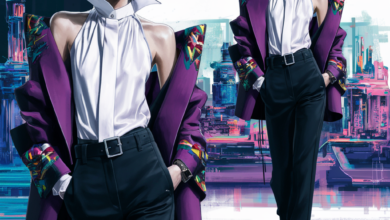
The Evolution of Streetwear: From Subculture to Mainstream
By FlairMagazine
Introduction
Streetwear has transcended its FlairMagazine humble beginnings as a niche subculture to become a dominant force in global fashion. What started as a movement rooted in skateboarding, hip-hop, and DIY aesthetics has now infiltrated high fashion runways, luxury collaborations, and everyday wardrobes. Brands like Supreme, Off-White, and BAPE have redefined what it means to be stylish, blending urban influences with high-end design. But how did streetwear evolve from underground scenes to a billion-dollar industry? In this deep dive, we explore the history, key players, cultural impact, and future of streetwear, examining why it continues to shape fashion trends worldwide.
1. The Origins of Streetwear: A Subcultural Phenomenon
Streetwear didn’t emerge from high-fashion ateliers but from the streets of New York, Los Angeles, and Tokyo in the 1980s and 1990s. Influenced by skateboarding, punk rock, and hip-hop, early streetwear was about rebellion and self-expression. Brands like Stüssy, founded by Shawn Stüssy, began by hand-printing T-shirts and selling them to surfers and skaters. Meanwhile, hip-hop artists like Run-D.M.C. popularized sportswear brands like Adidas, turning them into streetwear staples. In Japan, Harajuku’s vibrant youth culture fused American streetwear with avant-garde aesthetics, giving rise to brands like A Bathing Ape (BAPE). These early pioneers laid the foundation for a fashion revolution that prioritized authenticity over exclusivity.
2. The Rise of Streetwear Icons: Brands That Changed the Game
As streetwear gained momentum, certain brands became synonymous with the movement. Supreme, founded in 1994 by James Jebbia, started as a small skate shop in downtown Manhattan but quickly became a cultural phenomenon thanks to its limited-edition drops and bold branding. Off-White, created by Virgil Abloh, bridged the gap between streetwear and luxury, introducing high-fashion sensibilities to urban aesthetics. Meanwhile, brands like Palace and Fear of God brought British and high-end influences into the mix. Collaborations with artists, musicians, and even luxury houses (like Louis Vuitton x Supreme) propelled streetwear into the mainstream, proving its commercial and cultural power.
3. Streetwear and Hip-Hop: A Symbiotic Relationship
Hip-hop and streetwear have always been intertwined, with artists acting as both influencers and designers. From Run-D.M.C.’s iconic Adidas tracksuits to Pharrell Williams’ Billionaire Boys Club and Kanye West’s Yeezy, musicians have played a crucial role in shaping streetwear trends. Rappers didn’t just wear these brands—they became ambassadors, collaborators, and even founders. The rise of social media further amplified this relationship, with artists like Travis Scott and A$AP Rocky turning Instagram into a runway for the latest drops. Streetwear became more than clothing; it was a lifestyle, a status symbol, and a form of artistic expression deeply connected to music culture.
4. The Luxury Takeover: High Fashion Embraces Streetwear
What was once considered anti-establishment is now a cornerstone of luxury fashion. In 2017, Louis Vuitton’s collaboration with Supreme marked a turning point, proving that high-end brands could no longer ignore streetwear’s influence. Virgil Abloh’s appointment as Louis Vuitton’s Men’s Artistic Director further cemented this shift, blending street aesthetics with haute couture. Balenciaga, under Demna Gvasalia, embraced oversized silhouettes and graphic-heavy designs, while Gucci and Dior incorporated streetwear elements into their collections. The line between streetwear and luxury has blurred, creating a new fashion paradigm where exclusivity meets accessibility.
5. The Role of Sneakers in Streetwear Culture
No discussion of streetwear is complete without mentioning sneakers. From Air Jordans to Yeezys, sneakers are the ultimate status symbol in streetwear culture. Limited-edition releases, resale markets, and sneakerhead communities have turned footwear into a billion-dollar industry. Brands like Nike and Adidas dominate, but collaborations with designers (like Travis Scott x Air Jordan) and celebrities keep the hype alive. Sneaker culture isn’t just about comfort or style—it’s about identity, rarity, and the thrill of the hunt. The resale market, driven by platforms like StockX and GOAT, has turned sneakers into investments, with some pairs selling for thousands above retail price.
6. The Future of Streetwear: Sustainability, Tech, and Inclusivity
As streetwear continues to evolve, new challenges and opportunities arise. Sustainability is becoming a key concern, with brands like Noah and Patagonia leading the charge in ethical production. Meanwhile, technology is reshaping how we consume fashion—virtual sneakers, NFT wearables, and AI-designed clothing are pushing boundaries. Inclusivity is also at the forefront, with streetwear embracing gender-neutral designs and diverse representation. The next era of streetwear won’t just be about hype; it will be about innovation, responsibility, and staying true to its rebellious roots while adapting to a changing world.
FAQ: Common Questions About Streetwear
Q: What defines streetwear?
A: Streetwear is a style of casual clothing rooted in youth culture, blending elements of skate, hip-hop, sportswear, and DIY aesthetics. It often features bold graphics, logos, and limited-edition releases.
Q: Why are streetwear drops so hyped?
A: Limited supply, celebrity endorsements, and exclusivity drive demand. Brands like Supreme and Off-White use scarcity marketing to create urgency and cultural buzz.
Q: How has social media impacted streetwear?
A: Platforms like Instagram and TikTok have accelerated trends, allowing brands to reach global audiences instantly. Influencers and celebrities showcase new drops, fueling hype.
Q: Is streetwear still considered counterculture?
A: While it began as a rebellious movement, streetwear is now mainstream. However, underground scenes and independent brands continue to push boundaries.
Conclusion
Streetwear’s journey from subculture to global dominance is a testament to its adaptability and cultural resonance. What started as a niche style for skaters and hip-hop fans has reshaped the entire fashion industry, influencing luxury brands, music, and even technology. As streetwear moves forward, it faces new challenges—sustainability, digital innovation, and maintaining authenticity in a commercialized world. Yet, its core remains the same: a celebration of individuality, creativity, and the power of self-expression through clothing. Whether through a rare sneaker drop or a high-fashion collaboration, streetwear continues to define what it means to be cool in the 21st century.

